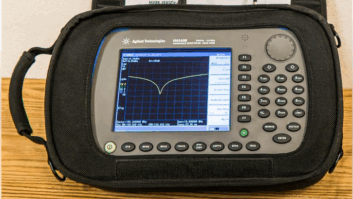Heavy rain can wreak havoc with any AM array.
Harry Bingaman of Sunbury Broadcasting took note of our raindrop picture of the improper Austin Ring installation (Workbench, Jan. 2).
(click thumbnail)Fig. 1: An inverted funnel prevents spark gap shorting.Heavy rain or deep snow would drench or bury the spark gaps in his five-tower array, resulting in a VSWR trip. The problem was most common during 10 kW day operation.
To solve the problem Harry inserted an upside-down funnel on each tower end of the spark gap, as seen in Fig. 1. Problem solved!
He recommends a good funnel made out of material that will not be affected by UV. Harry found that a yellow color works best.
Harry tried a clear plastic funnel, but it did not last very long. The only advantage was that the clear version did offer the opportunity to see the bees nest before they saw you.
Fig. 2 shows how the funnel is held in place by the upper portion of the spark gap, completely shielding the lower portion of the spark gap.
Thanks for your ingenuity, Harry — a great tip, inexpensive to implement, and it solves a problem.
* * *
(click thumbnail)Fig. 2: Insert the funnel over the upper spark gap arm.Barry Potter is a field service engineer based in Helena, Mont. Reading about the nesting habits of the white-footed mouse at both transmitter sites and antenna tuning units, Barry notes that in Montana and in other western and mountain states, this rodent is notorious for carrying the potentially fatal hantavirus infection.
The illness is transmitted by handling and inhalation of dust from the nests or any other materials contaminated with infected rodent urine and feces.
Most engineers are more attuned to not touching the HV or an RF line, and think little of sweeping rodent debris with a bare hand or inhaling its dust.
Barry says the local phone company provides a cleanup kit for their technicians. For cleanup, use a chlorine bleach solution in a 10:1 water-to-bleach mixture. Spray the solution on the material and in the area. The solution will help settle the dust and decontaminate the rubbish.
Make sure the power is off — both RF and AC — before attempting this inside an ATU!
Barry adds that rubber gloves and a HEPA respirator are also recommended precautions for use when cleaning up. See www.cdc.gov/ncidod/diseases/hanta/hps for details, including other species of rodents known to transmit the disease. Be sure to read the info under “Hantavirus Pulmonary Syndrome: What You Need to Know.”
Although Barry does some broadcast engineering in Montana, he’s worked on a variety of projects in Africa, installing both TV and radio transmitters. He’s seen quite a bit during his travels, but especially remembers a transmitter site in Malawi.
There, an RCA transmitter sat running with a polished brass plate affixed to it. The inscription: “A gift from the people of the United States to the people of Malawi by President John F. Kennedy.”
* * *
For broadcast engineers who must stay abreast of so many different subjects, the Internet is ideal.
Most broadcast equipment companies post a large amount of useful information on their sites, and some sponsor forums or e-newsletters to keep customers informed.
Clark Novak of Telos Systems writes in a recent e-newsletter that some improvements have been made to Telos Two, Two-x-12 and Series 2101 hybrids.
It was discovered that some units, serial numbers from 212AQ0800 to 212AT4850 (inclusive), have defective power supplies, and the power supply vendor has released a new version of the supply to correct the problem. For best performance, a procedure to check the supply capacitors can be found at www.zephyr.com/enews. You can also subscribe to the e-newsletter at this site.
* * *
Michael Barnes, technical director for the Salem Radio Network in Irving, Texas, notes that maintaining security is an increasing problem at remote sites these days. Though a well-lit site is a deterrent to intruders, some may disable your lights so their vandalism or theft cannot be seen.
Michael’s tip is to add current sensors on your perimeter and security lighting, similar to the ones you use on your tower lights. Hook the sensors up to your remote control alarms. When the lights get shot out, broken or even just burn out, you will get an alarm.
If you monitor the lights individually, and suddenly get alarms for multiple lights out, it’s time to call for backup.
Current sensors are cheap insurance for keeping your site secure.
* * *
(click thumbnail)Fig. 3: Painted plywood sheets can add a simple and economical layer of security to tower sites.Speaking of Salem, Fig. 3 was sent in by Scott Horner and Stu Engelke, showing the steps they took at WWDJ(AM), Hackensack, N.J., to thwart vandalism of the station’s diplexer and ATU.
Typically the space under the ATU is open — exposing copper strap, coaxial cable and the AC/control wiring. Even if the cables are contained in conduit, the copper strap would still be exposed.
You know that saying “out of sight, out of mind.” By screwing painted plywood sheets onto the ATU support legs, a potential thief can’t see the cables or strap. Not knowing what’s behind the panels, they probably won’t spend the time to remove all the screws securing the boards to the legs in order to get inside. Thanks Scott and Stu.
If you have a method of securing your site, share it with the readers of Workbench. Such solutions have never been more timely — or important.










